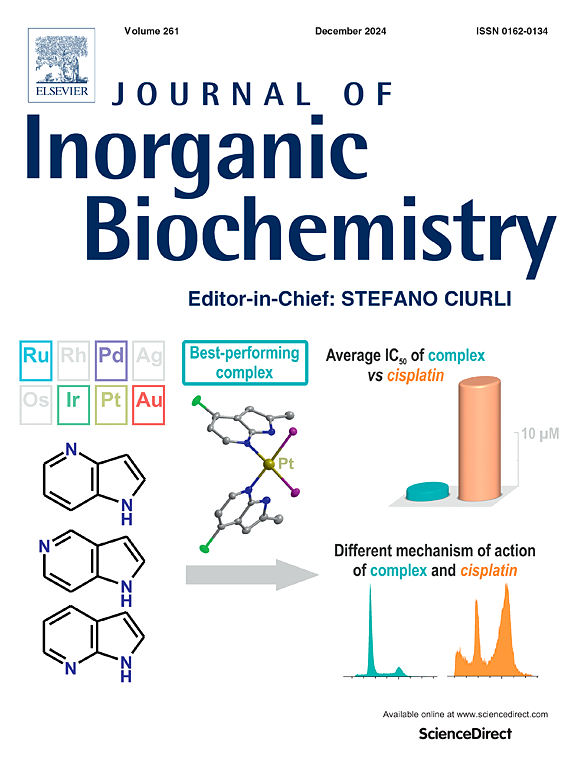选择性同位素标记研究了异双金属Mn/Fe蛋白的化学容量和反应机理
IF 3.8
2区 化学
Q2 BIOCHEMISTRY & MOLECULAR BIOLOGY
引用次数: 0
摘要
r2样配体结合氧化酶(R2lox)在O2活化后形成新的酪氨酸-缬氨酸交联,反映了一个整体的双电子氧化反应。然而,交联形成的机制仍存在争议,因为反应可以通过酪氨酸OH或缬氨酸CH键激活来启动。在这里,我们利用选择性同位素标记和几种光谱技术来探索这种氧化过程的机制。结果表明,R2lox具有活化CH键的能力,溶剂和CH的动力学同位素效应均约为2。通过快速冻灭EPR观察到高价MnIV/FeIV中间体的特征,该中间体类似于在异双金属自由基起始酶(Ic类核糖核苷酸还原酶)中发现的类似中间体。这项研究提供了可以被Mn/Fe辅因子切割的CH键自由能的下限,并表明这种酶在一系列反应中在功能上取代Fe/Fe辅因子的潜力。本文章由计算机程序翻译,如有差异,请以英文原文为准。
Selective isotope labeling probes the chemical capacity and reaction mechanism of a heterobimetallic Mn/Fe protein
The R2-like ligand binding oxidase (R2lox) forms a novel tyrosine-valine crosslink upon O2 activation, reflecting an overall two-electron oxidation reaction. However, the mechanism through which the crosslink is formed is under debate, as the reaction can be initiated through either tyrosine O![]() H or valine C
H or valine C![]() H bond activation. Here, we utilized selective isotopic labeling and several spectroscopic techniques to probe the mechanism of this oxidation process. The results suggest that R2lox is capable of performing C
H bond activation. Here, we utilized selective isotopic labeling and several spectroscopic techniques to probe the mechanism of this oxidation process. The results suggest that R2lox is capable of performing C![]() H bond activation, with both solvent and C
H bond activation, with both solvent and C![]() H kinetic isotope effects of approximately 2. Signatures of a high-valent MnIV/FeIV intermediate were observed through rapid-freeze-quench EPR that resemble an analogous intermediate found in the heterobimetallic radical-initiating enzyme, class Ic ribonucleotide reductase. This study provides a lower bound on the free energies of C
H kinetic isotope effects of approximately 2. Signatures of a high-valent MnIV/FeIV intermediate were observed through rapid-freeze-quench EPR that resemble an analogous intermediate found in the heterobimetallic radical-initiating enzyme, class Ic ribonucleotide reductase. This study provides a lower bound on the free energies of C![]() H bonds that can be cleaved by Mn/Fe cofactors and suggests the potential for such enzymes to functionally replace Fe/Fe cofactors in a range of reactions.
H bonds that can be cleaved by Mn/Fe cofactors and suggests the potential for such enzymes to functionally replace Fe/Fe cofactors in a range of reactions.
求助全文
通过发布文献求助,成功后即可免费获取论文全文。
去求助
来源期刊

Journal of Inorganic Biochemistry
生物-生化与分子生物学
CiteScore
7.00
自引率
10.30%
发文量
336
审稿时长
41 days
期刊介绍:
The Journal of Inorganic Biochemistry is an established international forum for research in all aspects of Biological Inorganic Chemistry. Original papers of a high scientific level are published in the form of Articles (full length papers), Short Communications, Focused Reviews and Bioinorganic Methods. Topics include: the chemistry, structure and function of metalloenzymes; the interaction of inorganic ions and molecules with proteins and nucleic acids; the synthesis and properties of coordination complexes of biological interest including both structural and functional model systems; the function of metal- containing systems in the regulation of gene expression; the role of metals in medicine; the application of spectroscopic methods to determine the structure of metallobiomolecules; the preparation and characterization of metal-based biomaterials; and related systems. The emphasis of the Journal is on the structure and mechanism of action of metallobiomolecules.
 求助内容:
求助内容: 应助结果提醒方式:
应助结果提醒方式:


